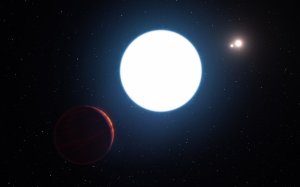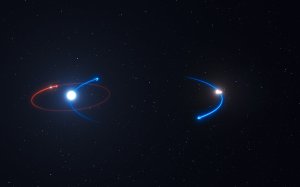Move over, Tatooine, astronomers have discovered a planet with not one, not two, but three suns.
Known as HD 131399Ab, the newly discovered planet is located 320 light-years from Earth in the constellation of Centaurus. The planet is estimated to be merely 16 million years old, making it one of the youngest exoplanets discovered so far.

The triple star system is made up of two smaller stars that twirl around together like a spinning dumbbell and a third, larger star. The two twirling stars orbit the third star at a distance of 300 astronomical units (1 astronomical unit is equal to the distance between the Earth and the sun). HD 131399Ab directly orbits the larger star. This complex triple-star dance is visualized in the video below.
With a triple-star system like this, someone standing on HD 131399Ab would witness triple sunrises and sunsets each day, during certain seasons. For half of the planet’s orbit, which lasts 550 Earth-years, all three stars are visible in the sky.
“The fainter two are always much closer together, and change in apparent separation from the brightest star throughout the year.” Kevin Wagner, PhD candidate at the University of Arizona and lead author on HD 131399Ab paper
Of course with temperatures reaching 580 degrees Celsius, it’s unlikely that life, as we know it, could exist on this planet to enjoy those romantic triple sunsets.
The exotic system was discovered by a team of astronomers led by the University of Arizona using the European Southern Observatory’s Very Large Telescope in Chile. Scientists previously believed that it was impossible for a system like this to exist. Because of the complexity of the changing gravitational attraction throughout an orbit, it was thought that stability could not be achieved and any planet would be tossed out of the system.
“If the planet was further away from the most massive star in the system, it would be kicked out of the system. Our computer simulations have shown that this type of orbit can be stable, but if you change things around just a little bit, it can become unstable very quickly.” Daniel Apai, Assistant Professor at the University of Arizona and co-author on HD 131399Ab paper

HD 131399Ab is particularly unique because it’s one of very few directly imaged exoplanets.
Because exoplanets are very faint and far away, they are often lost in the bright glare of the giant stars they orbit. For this reason, directly imaging an exoplanet is incredibly difficult, and most of the 2,000+ exoplanets confirmed to date have been found instead by detecting evidence of their existence, rather than a direct picture of the planet.
Using the transit method, astronomers can identify exoplanets by detecting the effect they have on their host star’s light as it passes in front of it. When a star’s light is dimmed periodically, it hints that a planet might be transiting in front of it.
Astronomers were able to successfully obtain a direct image of HD 131399Ab by using a specialized tool on ESO’s Very Large Telescope known as the SPHERE instrument. With SPHERE, astronomers studied a patch of sky in infrared light, and employed a sophisticated strategy to pluck out planetary heat signatures from their host stars’ signatures.
While a planet with three suns may seem particularly unique, the astronomer who led the study, Kevin Wagner, believes that they may be more common than we think.
“It is not clear how this planet ended up on its wide orbit in this extreme system…but it shows that there is more variety out there than many would have deemed possible. What we do know is that planets in multi-star systems have been studied far less often, but are potentially just as numerous as planets in single-star systems.” Kevin Wagner, PhD candidate at the University of Arizona and lead author on HD 131399Ab paper































Comment